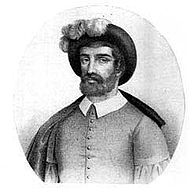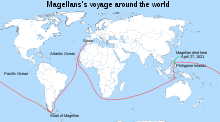- Juan Sebastián Elcano
-
Juan Sebastián Elcano 
Born Juan Sebastián Elcano
1476
Getaria, Gipuzkoa, Basque Country, SpainDied August 4, 1526 (aged 49–50)
Pacific OceanCause of death malnutrition Nationality Spanish Occupation explorer, navigator and mariner Known for first circumnavigation of the world. Religion Roman Catholic Partner María Hernández Dernialde Children Domingo Elcano III Parents Domingo Sebastián Elcano I, and Catalina del Puerto Relatives Domingo Elcano II, Martín Pérez Elcano and Antón Martín Elcano Juan Sebastián Elcano[1] (1476, Getaria, Gipuzkoa, Spain — 4 August 1526, Pacific Ocean) was a Basque Spanish explorer who completed the first circumnavigation of the world. As Ferdinand Magellan's second in command, Elcano took over after Magellan's death in the Philippines.
Contents
History
Early life
Elcano was born to Domingo Sebastián Elcano I and Catalina del Puerto. He had three brothers: Domingo Elcano II, a Christian priest, Martín Pérez Elcano, and Antón Martín Elcano. He fought in the war under orders of Gonzalo Fernández de Córdoba in Italy, and in 1509 he joined the Spanish expedition organized by Cardinal Francisco Jiménez de Cisneros against Algiers. He later settled in Seville and became a merchant ship captain. After violating Spanish laws by surrendering a ship to Genoan bankers in repayment of a debt, he sought a pardon from the Spanish king Charles I, by signing on as a subordinate officer for the Magellan expedition to the East Indies. He was spared by Ferdinand Magellan after taking part in a failed mutiny in Patagonia, and after five months of hard labour in chains, he was made captain of the galleon.
Magellan expedition
Elcano served as a naval commander of Charles I of Spain and took part of the expedition to the Philippines. They set sail with five ships, the Concepción, San Antonio, Santiago, Trinidad and Victoria with a fleet of 241 men from Spain in 1519. Dissatisfaction and severe weather plagued the voyage from the beginning and hostility among the Spaniards and Portuguese grew rapidly which led to the mutiny of some of his crew members. The Santiago was later destroyed by a storm. The fleet sailed across the Atlantic Ocean to the eastern coast of Brazil and into Puerto San Julián in Argentina. Several days later they discovered a passage known as the Strait of Magellan located in the southern tip of South America and sailed through the strait. The crew of the San Antonio mutinied and returned to Spain. On 28 November 1520, three ships set sail for the Pacific Ocean and about 19 men died before they reached Guam on 6 March 1521. Conflicts with the nearby island of Rota prevented Magellan and Elcano from resupplying their ships with food and water. They eventually gathered enough supplies and continued on with their journey to the Philippines and remained there for several weeks. Close relationship developed between the Spaniards and the islanders. They took part on converting the Cebuano tribes into Christianity and became involved in tribal warfare between rival Filipino groups in Mactan Island.
On 27 April 1521, Magellan was killed and the Spaniards defeated in the Battle of Mactan. The surviving members of the expedition could not decide who should succeed Magellan. The men finally voted on a joint command with the leadership divided between Duarte Barbosa and Jao Serrao. Within four days these two were also dead having died by being betrayed by a massacre at a feast at the hands of Rajah Humabon. The mission teetering on disaster, Joao Lopez Carvalho took command of the fleet and led it on a meandering journey through the Philippine archipelago.
During this six-month listless journey after Magellan died, and before reaching the Maluccas, Elcano's stature grew as the men became disillusioned with the weak leadership of Carvalho. The two ships, Victoria and Trinidad finally reached the destination of their mission, the Maluccas, on 6 November. The rested and re-supplied in this haven, and filled their holds with the precious cargo of cloves and spice. On 18 December, the ships were ready to leave. Trinidad sprung a leak, and was unable to be repaired. Carvalho stayed with ship along with 52 others hoping to return later.[2]
The Victoria, commanded by Elcano along with 17 other European survivors of the 240 man expedition and 4 (survivors out of 13) Timorese Asians continued its westward voyage to Spain crossing the Indian and Atlantic Ocean. They eventually reached Sanlúcar de Barrameda on 8 September 1522. One of the crew members of the Magellan and Elcano expedition was Italian scholar Antonio Pigafetta who had written several documents about the events of the expedition. According to Pigafetta the voyage covered 14,460 leagues about 81,449 kilometers. Elcano was awarded a coat of arms by Charles I of Spain, featuring a globe with the motto: Primus circumdedisti me (in Latin, "You went around me first")., and an annual pension. He never married but he had a son by María Hernández Dernialde named Domingo Elcano, whom he legitimized in his last will and testament. In 1572 to mark the 50th anniversary of the voyage King Philip II of Spain awarded the male heirs of Elcano the hereditary title of Marques de Buglas.
Loaísa expedition
In 1525, Elcano went back to sea, and became a member of the Loaísa Expedition. He was appointed leader along with García Jofre de Loaísa as captains, who commanded seven ships and sent to claim the East Indies for King Charles I of Spain. Both Elcano and Loaísa and many other sailors died of malnutrition in the Pacific Ocean, but the survivors reached their destination and a few of them managed to return to Spain.
See also
References
- ^ Elcano y no Cano
- ^ The Seafarers- The Explorers. Richard Humble. Time-Life Books. Alexandria, Virginia. 1978
External links
Categories:- Age of Discovery
- Basque explorers
- Basque people
- Circumnavigators of the globe
- Explorers of the Pacific
- People of Spanish colonial Philippines
- People who died at sea
- People from Gipuzkoa
- 16th-century Spanish people
- 1486 births
- 1526 deaths
Wikimedia Foundation. 2010.


